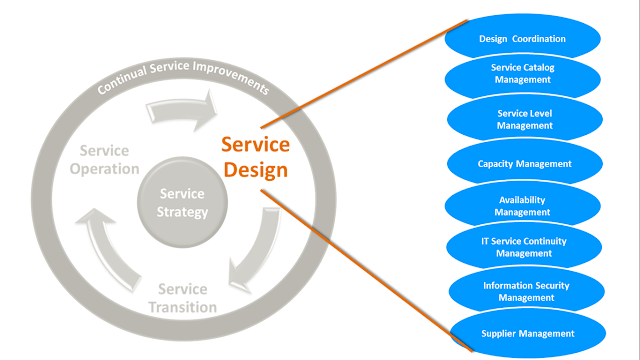Purpose of Service Design
The
Purpose of Service Design stage of the life-cycle is to design IT services,
together with the governing IT practices, processes and policies to realize the
service provider’s strategy and to facilitate the introduction of these
services into supported environments ensuring quality service delivery,
customer satisfaction and cost-effective service provision.
The value delivered by Service Design to the business:
- Reduce total cost of ownership
- Improve quality of service
- Improve consistency of service
- Ease the implementation of new or changed services
- Improve service alignment
- Improve service performance
- Improve IT governance
- Improve effectiveness of service management and IT processes
- Improve information and decision-making
- Improve alignment with customer values and strategies
Service Design Processes
There are eight main processes under Service Design stage of ITIL lifecycle:- Design Coordination
- Service Catalogue Management
- Service Level Management
- Capacity Management
- Availability Management
- IT Service Continuity Management
- Information Security Management
- Supplier Management
Service Catalogue Management process helps to ensure that a Service Catalogue is produced and maintained, containing accurate information on all operational services and those being prepared to be run operationally.
Service Level Management process helps to negotiate Service Level Agreements with the customers and to design services in accordance with the agreed service level targets.
Availability Management helps to focus on defining, analyzing, planning, measuring and improving all aspects of the availability of IT services.
IT Service Continuity Management helps to manage risks that could seriously impact IT services.
Information Security Management helps to ensure the confidentiality, integrity and availability of an organization's information, data and IT services.
Supplier Management helps to ensure that all contracts with suppliers support the needs of the business, and that all suppliers meet their contractual commitments.
Capacity Management process helps to ensure that the capacity of IT services and the IT infrastructure is able to deliver the agreed service level targets in a cost effective and timely manner.

No comments:
Post a Comment